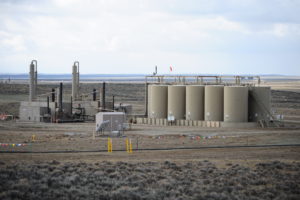By Angus M. Thuermer Jr., WyoFile.com

As leaders scramble to prop up the state’s troubled coal industry, a “new reality” threatens from another key sector: Declining natural gas production has cut Wyoming’s annual gas tax income 74% in 12 years.
In its best performing year in the last two decades — 2006 — natural gas generated upwards of 3.5 times more mineral severance taxes for Wyoming than coal, according to calculations from state revenue forecasters’ figures. The $669.5 million in taxes that year also far outpaced mineral severance taxes generated by crude oil.
Although experts say it’s unfair to compare the coalbed-methane boom of the mid-2000s to today’s energy landscape, they are predicting a continuing decline in natural gas revenues. When coupled with the slumping coal industry, the loss of natural gas revenue is creating a “new reality,” Sen. Cale Case (R-Lander) said recently.
“When I began serving in the Legislature, we believed coal would last 200 years,” Case said in a statement as Gov. Mark Gordon announced a planning effort to better report about Wyoming’s energy future. But annual mineral severance tax revenue from coal in 2019 will be down 38% from its zenith in 2011, according to WyoFile calculations from figures provided by state revenue forecasters.
Natural gas is following a similar path, with production declining in all but one year since 2009. If estimates revenue forecasters made in October prove true, Wyoming natural gas production will have declined 37% since 2009, they wrote.
That leaves the state’s three-legged economic stool with two short legs.
“They were all doing well,” when gas revenues started to slip years ago, Mark Watson, director of the Wyoming Oil and Gas Conservation Commission, said of oil, gas and coal. Today, however, Wyoming faces a budget-cutting predicament that holds a lesson, economist and former Rep. Mike Madden said.
“You can’t count on mineral revenues being very steady no matter what,” Madden said.
The $669.5 million Wyoming received from mineral severance taxes on natural gas in 2006 dwindled to $177.9 million in 2018, according to the Consensus Revenue Estimating Group. Natural gas prices a dozen years ago were “unprecedented,” Madden said, while today’s prices are “unbelievably low.
“It’s almost like night and day,” he said. The high of 2006 was “an aberration that probably won’t come back in my lifetime.”
Technological advancements such as horizontal drilling and hydraulic fracturing, or fracking, have provided a glut. Natural gas is also a byproduct in oil production and when that sector remains steady, as it is today, even more gas is delivered to the marketplace.
Wyoming rode the crest of the natural gas wave during its coalbed-methane boom. But natural gas production occurs all over the country today, including places that haven’t typically seen energy development, Madden said.
The number of natural gas rigs drilling in Wyoming in September dropped by almost a quarter from a year before — from 13 to 10 — “perhaps reflecting the beginning of some decline,” the revenue report reads. Decline, however, has been in the wings if not on stage for more than a year.
A year ago, EOG Resources laid off 17 employees in the Big Piney and Marbleton area, an economic consultant for the communities told the Sublette Examiner. An energy services company also closed its LaBarge office, the story said.
Jonah Energy laid off 16 employees in February, citing a “very depressed” natural gas market, according to the paper. Eleven of those given pink slips worked in Sublette County, five in Denver.
In October, the oil- and gas- field service company Haliburton laid off 650 employees across the Rocky Mountain region, numerous sources reported quoting a company statement. “Local market conditions” caused the Haliburton reductions in Rock Springs, according to the Casper Star-Tribune.
Ultra Petroleum Corp. idled one of three rigs drilling on the Pinedale Anticline in June and soon after said it would pull another from the field, according to Natural Gas Intelligence. In mid-September, Ultra said it would suspend all drilling in the area for the rest of the year and throughout 2020.
The drilling halt by the state’s largest oil and gas taxpayer is “an important data point,” revenue forecasters wrote in their October report. That’s because of naturally diminishing production from older wells compared to new ones. “No new drilling means continued declines of legacy wells [that are] not offset by new production,” the report reads.
Some investors have soured on energy stocks, the Wall Street Journal reported in October, citing “rock-bottom natural-gas sales.”
Unemployment rates across the state held steady at 3.8% between September and October, the state Department of Workforce Services reported last week. But gas-rich Sublette County led the state with 4.2% unemployment, up from 3.9% in September.
Despite the gas revenue woes, the state employed more than 18,000 people in the oil and gas field in 2018, the Petroleum Association of Wyoming said last week. Oil and gas contributed $1.39 billion in revenues to Wyoming, the association wrote in a statement, “equating to a direct payment of nearly $2,605 for every Wyoming resident.”
“Resource development, and specifically oil and natural gas, continues to be the primary driver of Wyoming’s economy,” PAW president Pete Obermueller said in the statement. “When the industry succeeds, Wyoming thrives.”
In its best performing year over the last two decades — 2006 — natural gas generated more than 2.25 times more mineral severance taxes for Wyoming than coal. The $669.5 million in mineral severance taxes that year, and in nine other years in the past two decades, outpaced mineral severance taxes generated by crude oil.
“It’s slowly gone down, down, down,” Watson said of natural gas. “The biggest problem is this glut.”
Natural gas production in 2020 will slip another 3.1%, revenue estimators predicted in October. Wyoming production will have declined 37% since 2009, if the production forecast for the rest of 2019 is accurate.
Madden said hope for the sector is elusive. “I can’t see much of a recovery there,” he said.








